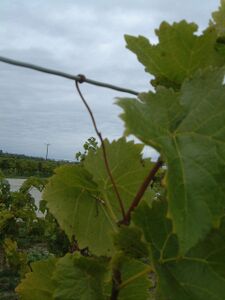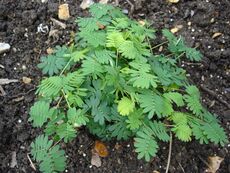إدراك النبات
The leaf closing after touch in Mimosa pudica depends on electrical signals
Plant perception is the ability of plants to sense and respond to the environment by adjusting their morphology and physiology.[1] Botanical research has revealed that plants are capable of reacting to a broad range of stimuli, including chemicals, gravity, light, moisture, infections, temperature, oxygen and carbon dioxide concentrations, parasite infestation, disease, physical disruption, sound,[2][3][4][5] and touch. The scientific study of plant perception is informed by numerous disciplines, such as plant physiology, ecology, and molecular biology.
جوانب الإدراج
الضوء

The sunflower, a common heliotropic plant which perceives and reacts to sunlight by slow turning movement
الجاذبية

Vine (Vitis) tendril. Note how the plant reaches for and wraps around the galvanised wire provided for the purpose. This is a very tough twig and appears to have no other purpose than support for the plant. Nothing else grows from it. It must reach out softly, then wrap around and then dry and toughen. See more at thigmotropism.
اللمس
الشم
Signal transduction
Plant hormones and chemical signals
Electrophysiology
إدراك الإشارة
Plant intelligence
Comparison with neurobiology
Parallels in other taxa
انظر أيضاً
- Auxin
- Biosemiotics
- Chemotropism
- Ethylene
- Gravitropism
- Heliotropism
- Hydrotropism
- Hypersensitive response
- Kairomone
- Kinesis (biology)
- Nastic movements
- Phytosemiotics
- Plant cognition
- Plant defense against herbivory
- Plant evolutionary developmental biology
- Plant perception (paranormal)
- Plant tolerance to herbivory
- Rapid plant movement
- The Secret Life of Plants
- Statocyte
- Stoma
- Systemic acquired resistance
- Taxis
- Thermotropism
- Tropism
المصادر
- ^ Trewavas A (سبتمبر 2005). "Green plants as intelligent organisms". Trends in Plant Science. 10 (9): 413–9. doi:10.1016/j.tplants.2005.07.005. PMID 16054860.
- ^ Gagliano M, Mancuso S, Robert D (يونيو 2012). "Towards understanding plant bioacoustics". Trends in Plant Science. 17 (6): 323–5. doi:10.1016/j.tplants.2012.03.002. PMID 22445066.
- ^ Gagliano M (يوليو 2013). "Green symphonies: a call for studies on acoustic communication in plants". Behavioral Ecology. 24 (4): 789–796. doi:10.1093/beheco/ars206. PMC 3677178. PMID 23754865.
- ^ Gagliano M, Grimonprez M, Depczynski M, Renton M (مايو 2017). "Tuned in: plant roots use sound to locate water". Oecologia. 184 (1): 151–160. Bibcode:2017Oecol.184..151G. doi:10.1007/s00442-017-3862-z. PMID 28382479. S2CID 5231736.
- ^ Mishra RC, Ghosh R, Bae H (أغسطس 2016). "Plant acoustics: in the search of a sound mechanism for sound signaling in plants". Journal of Experimental Botany. 67 (15): 4483–94. doi:10.1093/jxb/erw235. PMID 27342223.
قراءات إضافية
- Baluška F (ed) (2009). Plant-Environment Interactions: From Sensory Plant Biology to Active Plant Behavior. Springer Verlag.
- Brenner ED, Stahlberg R, Mancuso S, Vivanco J, Baluska F, Van Volkenburgh E (أغسطس 2006). "Plant neurobiology: an integrated view of plant signaling". Trends in Plant Science. 11 (8): 413–9. doi:10.1016/j.tplants.2006.06.009. PMID 16843034.
- Cvrcková F, Lipavská H, Zárský V (مايو 2009). "Plant intelligence: why, why not or where?". Plant Signaling & Behavior. 4 (5): 394–9. doi:10.4161/psb.4.5.8276. PMC 2676749. PMID 19816094.
- Garzón FC (يوليو 2007). "The quest for cognition in plant neurobiology". Plant Signaling & Behavior. 2 (4): 208–11. doi:10.4161/psb.2.4.4470. PMC 2634130. PMID 19516990.
- Gilroy S, Masson PH (2007). Plant Tropisms. Iowa State University Press.
- Karban R (يوليو 2008). "Plant behaviour and communication". Ecology Letters. 11 (7): 727–39. doi:10.1111/j.1461-0248.2008.01183.x. PMID 18400016.
- Karban R (2015). Plant Sensing and Communication. University of Chicago Press.
- Mancuso S, Shabala S (2006). Rhythms in Plants. Springer Verlag.
- Manetas, Yiannis (2012). "Are Plants Intelligent Organisms After All?". Alice in the Land of Plants. Berlin, Heidelberg: Springer Berlin Heidelberg. pp. 323–342. doi:10.1007/978-3-642-28338-3_10. ISBN 978-3-642-28337-6.
- Scott P (2008). Physiology and Behaviour of Plants. John Willey & Sons Ltd.
- Trewavas A (يوليو 2003). "Aspects of plant intelligence". Annals of Botany. 92 (1): 1–20. doi:10.1093/aob/mcg101. PMC 4243628. PMID 12740212.
- Trewavas A (سبتمبر 2005). "Plant intelligence". Die Naturwissenschaften. 92 (9): 401–13. Bibcode:2005NW.....92..401T. doi:10.1007/s00114-005-0014-9. PMID 16142448. S2CID 26665579.
- Trewavas A (يونيو 2009). "What is plant behaviour?". Plant, Cell & Environment. 32 (6): 606–16. doi:10.1111/j.1365-3040.2009.01929.x. PMID 19143994.
- Volkov AG (2006). Plant Electrophysiology. Springer Verlag.
- Volkov AG, Carrell H, Adesina T, Markin VS, Jovanov E (يوليو 2008). "Plant electrical memory". Plant Signaling & Behavior. 3 (7): 490–2. doi:10.4161/psb.3.7.5684. PMC 2634440. PMID 19704496.
- Keen NT, Mayama S, Leach JE, Tsujumu S, eds. (2001). Delivery and Perception of Pathogen Signals in Plants. APS Press. p. 268. ISBN 0-89054-259-7.
- Taiz L, Zeiger E (2006). Plant Physiology, fourth edition. Sinauer Associates. p. 700 (est). ISBN 0-87893-856-7.
- Miller D, Hable W, Gottwald J, Ellard-Ivey M, Demura T, Lomax T, Carpita N (ديسمبر 1997). "Connections: the hard wiring of the plant cell for perception, signaling, and response". The Plant Cell. 9 (12): 2105–17. doi:10.1105/tpc.9.12.2105. PMC 157061. PMID 9437857.
- Scheel D, Wastermack C (مايو 2002). Plant Signal Transduction. Oxford University Press. p. 346. ISBN 978-0-19-963879-6. Retrieved 25 ديسمبر 2006.
- Taiz L, Zeiger E (2002). Plant Physiology Online: A companion to Plant Physiology (Third ed.). Sinauer Associates. Archived from the original on 7 ديسمبر 2006. Retrieved 26 ديسمبر 2006.
وصلات خارجية
- Plant Neurobiology Society
- Plant Signaling and Behavior Scientific journal for Plant Neurobiology
- Study hints plants have sensibilities
- Plants cannot "think and remember," but there's nothing stupid about them: They're shockingly sophisticated
- How Does a Venus Flytrap Work?
- Plant Neurobiology: “Foolish distraction” or “new science”?
This article may include material from Wikimedia licensed under CC BY-SA 4.0. Please comply with the license terms.

